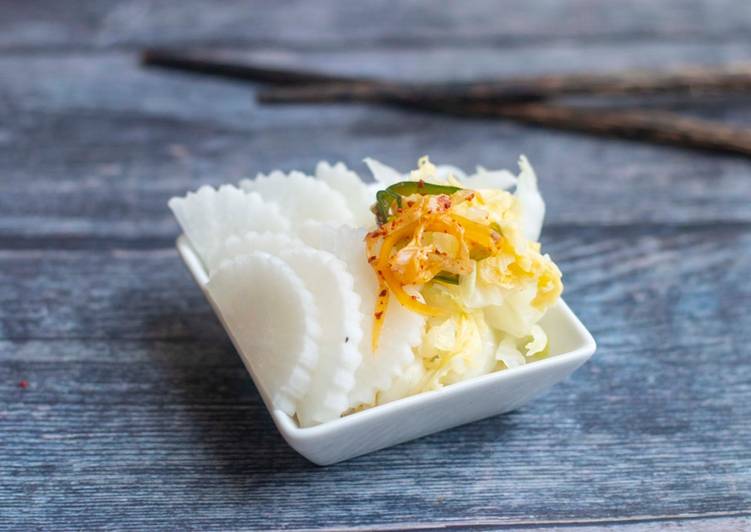Vegetable Pickles or tsukemono
Vegetable Pickles or tsukemono. Japanese pickles—known collectively as tsukemono—can easily go unnoticed as part of a washoku (traditional Japanese) meal. Yet they've rightfully earned their place as a cornerstone food because they serve an important purpose: Japanese food culture is heavily influenced by principles of balance. Japanese Pickles or Tsukemono (漬物) are a delicious way to preserve vegetables.
 Pickling is a great way to preserve fresh vegetables, and today I'm gonna show you how to make Japanese Pickles, or Tsukemono, three different ways. Tsukemono (漬物), or Japanese pickles, are preserved vegetables that are pickled in salt, salt brine, or rice bran. They come in great varieties and forms Nukazuke also refers to both the pickles and the pickling method. You can cook Vegetable Pickles or tsukemono using 9 ingredients and 6 steps. Here is how you cook it.
Pickling is a great way to preserve fresh vegetables, and today I'm gonna show you how to make Japanese Pickles, or Tsukemono, three different ways. Tsukemono (漬物), or Japanese pickles, are preserved vegetables that are pickled in salt, salt brine, or rice bran. They come in great varieties and forms Nukazuke also refers to both the pickles and the pickling method. You can cook Vegetable Pickles or tsukemono using 9 ingredients and 6 steps. Here is how you cook it.
Ingredients of Vegetable Pickles or tsukemono
- It's 1 of Daikon or Mooli.
- You need 1 of chinese cabbage.
- Prepare of Vinegar mixture per 1 vegetable.
- It's 1/2 cup of sugar.
- Prepare 3/4 cup of white vinegar.
- Prepare 1 of lemon.
- You need 1 cup of warm water.
- Prepare Pinch of sea salt.
- It's 1-2 of big red chilli (optional).
The vegetables are preserved in a brown pungent mash of roasted rice bran (Nuka. Tsukemono pickles actually means pickled foods and can refer to a wide assortment of both vegetables and fruits, as well as seaweed. Made using either a salt or vinegar brine or a more involved fermentation process, Japanese pickles, referred to as tsukemono, are comprised of more. Pickled Vegetables - Tsukemono Tsukemono, or Japanese pickled vegetables are a trademark snack or rice accompaniment found in all Japanese I've gotten into pickling lately; Korean pickles, pickled daikon, cucumber pickles and cucumber kimchi (spicy!), enjoying the simplicity and ease of.
Vegetable Pickles or tsukemono instructions
- Use one daikon. Peel the skin off..
- Cut them into long chunks. Place them in a big container..
- To make pickling marinade. Combine sugar, salt and vinegar until the sugar dissolves. (You can add chilli at this at.
- Add some lemon and mix all..
- Pour the pickling marinade sauce in to the daikon. Cover with lid. Leave it over night at room temperature. Ready to eat after 6 hours or the next day..
- Do the same method with chinese canbage but cut your cabbage vertically..
Japanese pickles (�Е�, tsukemono) are an important part of the Japanese diet. Tsukemono first appeared way back in Japanese history in the days before refrigeration when pickling was All kinds of vegetables and some fruits are used to make tsukemono including, but not limited to, Japanese. Tsukemono (漬物, literally "pickled things") are Japanese preserved vegetables (usually pickled in salt, brine, or a bed of rice bran). They are served with rice as an okazu (side dish), with drinks as an otsumami (snack), as an accompaniment to or garnish for meals. Another category of pickle is the dried vegetable pickle.